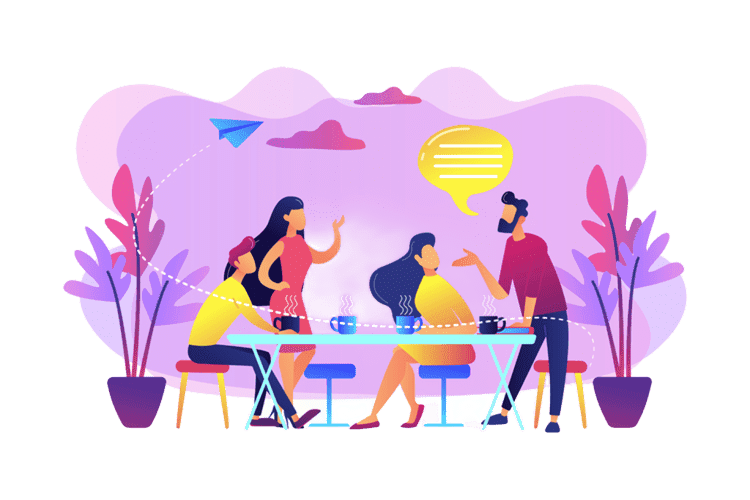[dsm_gradient_text gradient_text="Implementing ISO 18404 in Your Organization: A Practical Guide" _builder_version="4.27.0" _module_preset="default" header_font="Questrial|||on|||||" header_text_align="center" header_letter_spacing="5px" filter_hue_rotate="100deg"...
How Matching People with the Right Company Vibes Boosts Team Trust and Performance
Learn how aligning personal and company values enhances team trust and performance. Discover the power of person-organization fit in recruitment and the role of respect-for-people culture in creating high-performing teams. Unlock the secrets to effective teamwork and organizational success.

In today’s work environment, it’s all about teams. Whether you’re coding the next big app, launching a marketing campaign, or working on groundbreaking research, chances are you’re doing it with a team. But what makes some teams totally crush it while others just crash and burn? A big part of the answer might be something called person-organization fit, or P-O fit for short. That’s basically a fancy way of saying how well your personal values and vibes match with the company’s. Think of it like finding your perfect match on a dating app – only, instead of swiping right on a person, you’re swiping right on a whole company.
Recent research by Hu, Yao, and Zhang (2020) dives deep into how P-O fit can make a big difference not just for individuals, but for entire teams. They found that when people are hired based on how well they fit with the company’s values, it boosts trust among team members, which then leads to better team performance. But there’s a twist: this effect depends on how much the company already values respect and fairness. If a company has a strong culture of respect, the benefits of P-O fit aren’t as pronounced. Let’s break down what all this means for teams, companies, and the people working in them.
What Exactly is Person-Organization Fit (P-O Fit)?
Before we go any further, let’s make sure we’re all on the same page about what P-O fit is. P-O fit is the idea that you’ll do your best work if your personal values, beliefs, and goals line up with those of the company you work for. Imagine a company where everyone is super focused on teamwork, collaboration, and making a positive impact on the world. If you care about those things too, you’re going to feel right at home. But if you’re all about competition, individual achievements, and just chasing the paycheck, you might find yourself feeling out of place and disconnected.
When companies hire people who fit well with their culture, it’s like putting together pieces of a puzzle. The pieces click, and the picture starts to make sense. This kind of fit doesn’t just make employees happier and more committed; it can also make teams work better together. Think about it: if you and your coworkers share similar values, you’re more likely to trust each other, communicate openly, and help each other out.
Why Should We Care About P-O Fit in Teams?
Okay, so P-O fit is great for individuals – but why should we care about it at the team level? Teams are the building blocks of modern companies. They’re where the magic happens. But for a team to work well, it’s not enough for each person to be good at their job. They also need to work well with others, trust each other, and share common goals. That’s where P-O fit comes in.
Hu and her colleagues found that when companies focus on P-O fit during recruitment, it has a ripple effect that goes beyond just making individuals happier. It helps the whole team perform better by building what’s known as intra-team trust. This is the kind of trust that happens when team members believe that everyone is on the same page and will support each other. With strong intra-team trust, team members are more likely to communicate openly, collaborate effectively, and take risks that lead to innovation.
The Role of Trust in Teamwork
Let’s talk a little more about trust because it’s a pretty big deal. Imagine you’re working on a group project, and you’ve got this one person who always does their part and helps others out. You’d trust that person, right? Now, imagine there’s another person who’s always slacking off or taking credit for others’ work. Not so trustworthy, huh? Trust is what makes you feel comfortable relying on others and being open about your thoughts and ideas.
Intra-team trust is just that – the trust within a team. It’s the feeling that your teammates have your back, won’t judge you for mistakes, and will put the team’s goals ahead of their own personal agendas. When there’s a high level of trust, teams are more cohesive. People communicate better, share more ideas, and are more willing to take on challenging tasks because they know their team is there to support them.
%
Impact of Trust on Team Performance
Research has shown that teams with high levels of trust among members are up to 50% more likely to achieve their goals effectively compared to teams with low trust levels. This increased performance is attributed to better communication, collaboration, and reduced conflict within the team.
%
Trust and Employee Retention
Studies indicate that high-trust organizations experience 76% more engagement from their employees than low-trust organizations. Furthermore, employees in high-trust environments are 50% more likely to stay with their company over the next year.
How P-O Fit Boosts Intra-Team Trust
So, how exactly does P-O fit build this kind of trust? It all comes down to shared values and open communication. When people are hired based on how well their values align with the company’s, they’re more likely to share those values with their teammates. This shared value system makes it easier for people to understand each other and predict how others will act. It’s like having a common language that makes communication smoother and more effective.
Hu and her team found that P-O fit encourages three main things that build trust:
- Communication: When you share values with your teammates, you’re more likely to feel comfortable speaking openly and honestly. This reduces misunderstandings and builds trust over time.
- Predictability: Knowing that your teammates value the same things as you do makes their actions more predictable. You know they’ll act in ways that align with those shared values, which reduces uncertainty and builds trust.
- Attraction: People tend to like and trust others who are similar to them. It’s human nature. If you feel that your teammates share your core values, you’re more likely to feel connected to them and trust them.
The Moderating Role of Respect-for-People Culture
Now, here’s where things get interesting. The study found that the impact of P-O fit on intra-team trust and team performance depends on the company’s overall culture, specifically its respect-for-people (RFP) culture. An RFP culture is all about mutual respect, fairness, and tolerance. It’s the kind of culture where everyone feels valued and heard, regardless of their position or background.
In companies with a strong RFP culture, the positive effects of P-O fit aren’t as strong. Why? Because in these companies, there’s already a high level of respect and fairness that helps build trust, even if team members don’t share the exact same values. But in companies where RFP culture is weak, P-O fit becomes much more important. Without a strong culture of respect, shared values become the main way to build trust and cooperation within teams.
What Does This Mean for Hiring and Team Building?
So, what’s the takeaway for companies looking to build high-performing teams? First off, it’s clear that considering P-O fit during the hiring process can pay off big time. By hiring people who align with the company’s values, organizations can build teams that trust each other, communicate better, and perform at a higher level. This doesn’t just apply to the new hires, either. When existing team members see that new hires fit well with the company’s culture, it reinforces their own sense of belonging and commitment.
Here’s how companies can put this into practice:
1. Value-Based Recruitment
Develop interview questions and assessment tools that help identify candidates whose values align with the company’s. This could include situational questions that reveal how candidates would handle specific scenarios or asking them to describe their personal values and how they align with the company’s mission.
2. Cultural Onboarding
Don’t just leave new hires to figure out the company culture on their own. Use onboarding programs to clearly communicate the company’s values and expected behaviors. Help new hires understand how these values are put into practice in day-to-day work.
3. Foster a Respect-for-People Culture
Even if you’re hiring for P-O fit, it’s still important to create a broader culture of respect and fairness. This can be achieved through training programs, leadership development, and policies that promote inclusivity and respect for all employees. When respect is embedded in the company culture, it creates a safety net that supports trust and collaboration.
4. Continuous Feedback and Alignment
Regularly check in with team members to make sure they feel aligned with the company’s values and each other. Encourage open dialogue about what’s working and what’s not. This helps catch potential misalignments early and keeps everyone on the same page.
What Does This Mean for Hiring and Team Building?
While the study highlighted the importance of trust, P-O fit also impacts team performance in other ways. When team members feel aligned with the company’s values, they are more committed to their work and motivated to contribute to the team’s success. This alignment also leads to higher job satisfaction, which reduces turnover and helps maintain team stability. Stable teams are more cohesive and better able to work together towards common goals.
Additionally, when team members share common values, they are more likely to engage in behaviors that go above and beyond their job descriptions. This is known as organizational citizenship behavior (OCB). OCB includes actions like helping a teammate with their workload, volunteering for extra projects, or suggesting improvements to processes. Teams with high levels of OCB are often more innovative and adaptable, which is crucial in today’s fast-paced business environment.
The Importance of Context
One of the most important takeaways from this research is that the effectiveness of P-O fit depends on the context. In organizations where respect and fairness are already strong, P-O fit plays a less critical role in building trust. This doesn’t mean it’s not important, but rather that other factors, like the company’s existing culture, can also support trust and performance.
In contrast, in organizations where the culture of respect is weaker, P-O fit becomes a key driver of trust and team performance. For these companies, investing in P-O fit during recruitment can be a game-changer, helping to build the kind of cohesive, high-performing teams that are essential for success.
Real-World Applications and Examples
Let’s look at some real-world examples to see how this plays out. Take a company like Google, known for its strong, inclusive culture and emphasis on innovation. Google not only hires for skills but also looks for candidates who fit their unique culture of collaboration and creativity. They’ve created an environment where P-O fit naturally leads to high trust and teamwork, which is crucial for innovation. In Google’s case, their respect-for-people culture reinforces the positive effects of P-O fit, making teams more effective and boosting overall company performance.
On the other hand, consider a startup that’s still trying to find its footing. Maybe they don’t have established cultural norms or a strong RFP culture yet. For these companies, focusing on P-O fit during recruitment can help create the initial foundation of trust among team members. As new hires bring shared values into the team, trust builds up, making it easier for the company to grow and establish a positive culture over time.
What Gen Z Needs to Know About P-O Fit
As members of Gen Z enter the workforce, understanding the concept of P-O fit can be incredibly valuable. Gen Z values authenticity, transparency, and a sense of purpose at work. By seeking out employers that align with these values, Gen Z workers can find roles where they are not only more satisfied but also more effective and influential.
Here’s what Gen Z should keep in mind:
1. Research Potential Employers
Look beyond the job description and salary. Research the company’s mission, values, and culture. Are they just buzzwords, or do they seem to truly guide the company’s actions? Glassdoor reviews, social media, and talking to current or former employees can provide insight.
2. Ask the Right Questions During Interviews
Don’t be afraid to ask about the company culture, team dynamics, and how the company ensures a good fit between employees and organizational values. Questions like, “Can you tell me about a time when the company’s values influenced a major decision?” can give you a sense of how deeply those values are embedded.
3. Trust Your Instincts
If something feels off during the interview process, it probably is. Pay attention to how people treat you during interviews, how transparent the company is about its values, and whether those values seem to align with yours. Remember, it’s not just about them picking you – it’s about you picking them, too.
4. Look for Signs of a Strong Respect-for-People Culture
A company that values respect will typically have clear policies on diversity, equity, and inclusion, as well as programs to support employee well-being and development. Companies with these attributes are more likely to foster environments where trust and teamwork thrive, regardless of P-O fit.
Advice for HR Practitioners and Leaders
If you’re in HR or a leadership position, there are practical steps you can take to leverage P-O fit and create high-performing teams:
1. Develop a Clear Understanding of Your Company’s Values
Ensure that the company’s core values are not just words on a wall but are actively lived and demonstrated by leadership. This clarity makes it easier to attract and select candidates who align with those values.
2. Use P-O Fit as a Screening Tool
Incorporate questions that assess value alignment into the hiring process. Behavioral interview questions and personality assessments can help gauge whether a candidate’s values align with the company’s.
3. Train Managers and Team Leaders
Managers play a crucial role in maintaining company culture and fostering team trust. Provide them with training on how to recognize and cultivate P-O fit within their teams, and how to reinforce the organization’s values through their daily actions.
4. Promote and Model Respect-for-People Culture
Even if you hire for P-O fit, fostering a culture of respect is essential. Implement policies that promote fairness, inclusivity, and open communication. Lead by example to show that respect is a core value.
5. Monitor and Adapt
Regularly check in with employees to gauge their sense of fit and trust within the team. Use surveys, feedback sessions, and performance metrics to understand what’s working and where adjustments are needed.
The Bigger Picture: P-O Fit and the Future of Work
The insights from this research are more than just tips for building better teams—they are part of a larger conversation about the future of work. As more companies adopt remote and hybrid work models, building trust and maintaining cultural alignment can become more challenging. P-O fit can serve as a valuable tool for ensuring that teams remain cohesive and effective, even when team members are not working from the same physical location.
Furthermore, with increasing awareness of mental health and well-being, companies that prioritize P-O fit and a respect-for-people culture are likely to see benefits in employee engagement, retention, and overall well-being. When people feel they belong and are respected, they are more likely to be happy and productive at work.
Conclusion
In today’s fast-paced and ever-changing work environment, finding the right people to fit your company is more important than ever. By focusing on person-organization fit during recruitment and building a culture of respect, companies can create teams that not only perform well but also trust and support each other. This research shows that it’s not just about hiring the smartest or most skilled candidates; it’s about finding those who align with the company’s values and will thrive within its culture.
For Gen Z, understanding the importance of P-O fit can help you find a job that’s not just a paycheck but a place where you can grow, make an impact, and feel valued. For companies, this focus can lead to more engaged employees, better team performance, and a stronger, more positive workplace culture. In the end, it’s about making the right match – one that benefits both the individual and the organization, creating a win-win situation where everyone can thrive.
References
- Hu, Q., Yao, J., & Zhang, Z.-X. (2020). Selecting people based on person‐organisation fit: Implications for intrateam trust and team performance. Human Resource Management Journal.
- Kristof, A. L. (1996). Person-organization fit: An integrative review of its conceptualizations, measurement, and implications. Personnel Psychology.
- Rousseau, D. M., Sitkin, S. B., Burt, R. S., & Camerer, C. (1998). Not so different after all: A cross-discipline view of trust. Academy of Management Review.
- Mathieu, J., Maynard, M. T., Rapp, T., & Gilson, L. (2008). Team effectiveness 1997-2007: A review of recent advancements and a glimpse into the future. Journal of Management.
- Edwards, J. R., & Cable, D. M. (2009). The value of value congruence. Journal of Applied Psychology.
Wanna know more? Let's dive in!
The Essential Skills and Knowledge Areas Covered by ISO 18404
[dsm_gradient_text gradient_text="Mastering ISO 18404: Essential Lean Six Sigma Competencies and Knowledge Areas" _builder_version="4.27.0" _module_preset="default" header_font="Questrial|||on|||||" header_text_align="center" header_letter_spacing="5px"...
The Future of Lean and Six Sigma
[dsm_gradient_text gradient_text="The Future of Lean and Six Sigma: How ISO 18404 is Shaping the Industry" _builder_version="4.27.0" _module_preset="default" header_font="Questrial|||on|||||" header_text_align="center" header_letter_spacing="5px"...
ISO 18404 vs. Other Lean and Six Sigma Certifications
[dsm_gradient_text gradient_text="ISO 18404 vs. Other Lean and Six Sigma Certifications: What's the Difference?" _builder_version="4.27.0" _module_preset="default" header_font="Questrial|||on|||||" header_text_align="center" header_letter_spacing="5px"...
Calibration vs. Verification in ISO 17025
[dsm_gradient_text gradient_text="Calibration vs Verification in ISO/IEC 17025: A Laboratory Manager's Guide" _builder_version="4.27.0" _module_preset="default" header_font="Questrial|||on|||||" header_text_align="center" header_letter_spacing="5px"...
ISO 17025 for Small Labs: Scaling Accreditation Without Breaking the Bank
[dsm_gradient_text gradient_text="ISO 17025 for Small Labs: Scaling Accreditation Without Breaking the Bank" _builder_version="4.27.0" _module_preset="default" header_font="Questrial|||on|||||" header_text_align="center" header_letter_spacing="5px"...
ISO 17025, Laboratories, and AI: A New Era of Compliance and Innovation
[dsm_gradient_text gradient_text="ISO 17025, Laboratories, and AI: A New Era of Compliance and Innovation" _builder_version="4.27.0" _module_preset="default" header_font="Questrial|||on|||||" header_text_align="center" header_letter_spacing="5px"...
The Future of ISO/IEC 17025 and Its Impact on the Testing and Calibration Industry
[dsm_gradient_text gradient_text=" Looking Ahead: The Future of ISO/IEC 17025 and Its Impact on the Testing and Calibration Industry" _builder_version="4.27.0" _module_preset="default" header_font="Questrial|||on|||||" header_text_align="center"...
How ISO/IEC 17025 Powers Quality and Compliance in the Automotive Industry
[dsm_gradient_text gradient_text="How ISO/IEC 17025 Powers Quality and Compliance in the Automotive Industry" _builder_version="4.27.0" _module_preset="default" header_font="Questrial|||on|||||" header_text_align="center" header_letter_spacing="5px"...
Ensuring ISO 26262 Functional Safety with SHARC in Automotive Systems
[dsm_gradient_text gradient_text="Ensuring ISO 26262 Functional Safety with SHARC in Automotive Systems" _builder_version="4.27.0" _module_preset="default" header_font="Questrial|||on|||||" header_text_align="center" header_letter_spacing="5px"...
Driving the Future of EV Batteries: Advanced BMS Technologies and Trends
[dsm_gradient_text gradient_text="Driving the Future of EV Batteries: Advanced BMS Technologies and Trends" _builder_version="4.27.0" _module_preset="default" header_font="Questrial|||on|||||" header_text_align="center" header_letter_spacing="5px"...
ISO 26262: Ensuring Functional Safety in Automotive Systems
[dsm_gradient_text gradient_text="ISO 26262: Ensuring Functional Safety in Automotive Systems" _builder_version="4.27.0" _module_preset="default" header_font="Questrial|||on|||||" header_text_align="center" header_letter_spacing="5px" filter_hue_rotate="100deg"...












